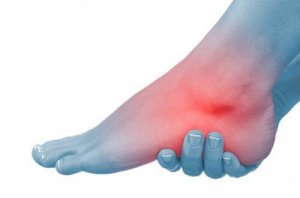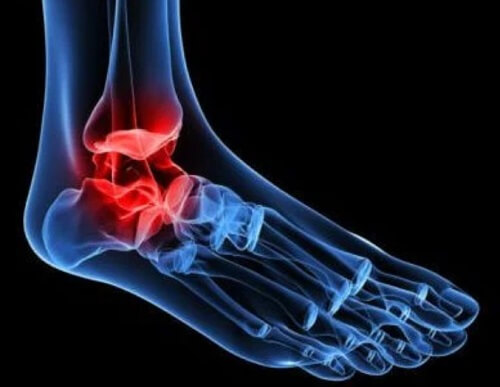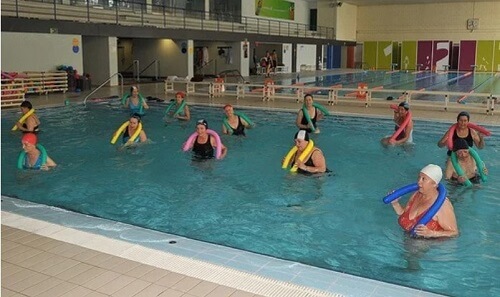Ankle Osteoarthritis Symptoms and Treatments


Written and verified by psychologist Valeria Sabater
Ankle osteoarthritis symptoms limit many people’s quality of life. It’s a silent and persistent illness that impedes mobility. Moreover, the pain it causes doesn’t always subside after taking a painkiller.
Although more people frequently talk of hip or knee wear and tear, ankle osteoarthritis is a very common type of osteoarthritis associated with degenerative diseases.
Also, we mustn’t forget that the ankle joint is very important for walking. In addition, its function is essential so that our postural axis formed by the hip, the knee and the foot are in harmony.
However, there are several factors that affect the delicate health and endurance of all the complex structures that form this joint.
Osteoarthritis is undoubtedly the evil that acts as a real curse in our quality of life. Below you’ll find more information about ankle osteoarthritis symptoms and treatments.
We are sure it will help you.
How Ankle Osteoarthritis Occurs
This type of arthritis is caused by progressive wear and tear of the ankle joint’s cartilage. It’s common that our ankles become stiff and develop deformities as we age.
Try this: Anti-Inflammatory Smoothie May Relieve Joint Pain

The causes that favor the appearance of ankle osteoarthritis can be multiple:
- Having suffered various sprains.
- Being an athlete.
- The presence of cysts or abnormal bone growth.
However, autoimmune disorders such as rheumatoid arthritis or psoriasis also often lead to the progressive onset of this problem.
- Traumatologists also say there is peculiar cause of this condition: the deformity of the ankle itself. Sometimes, we are more likely to develop osteoarthritis over time just by having flat feet.
Finally, there’s not always a specific cause of ankle osteoarthritis. Sometimes we suffer from what is known as “primary osteoarthritis”, which mainly affects the elderly.
What are the ankle osteoarthritis symptoms?
The first warning of cartilage wear and tear in this joint is pain when walking. At first we’ll notice it after a long walk.
- Pressure or more specifically sharp pain in the ankle area appears when walking, which forces us to rest our ankle for a few minutes to relieve the pain.
- Later, our ankle may become swollen and it may even be difficult to wear a certain type of footwear.
- Also, many patients complain of pain during the night.
- We can develop the painful calcaneal spur that we mentioned above, little by little and due to the progressive deformity that can happen to our ankle.
Read also: Osteoarthritis, Osteoporosis and Arthritis: What Are the Differences?
Treatments to alleviate ankle osteoarthritis symptoms

Ankle Joint Injection
One of the most common treatments are articular injections made of hyaluronic acid or corticosteroids.
The injections improve the mobility of the joint temporarily, since they “lubricate” it. Again, we must point out that the effect is temporary.
Special insoles
A specialist’s opinion is fundamental in these cases. They will recommend the most appropriate treatment for us according to our symptoms.
- Another common strategy is the use of corrective insoles. The aim of using them is to accommodate and correct the foot deformity of the patient.
- They also help reduce the impact force of walking on the ankle and minimize pain.
- There are also certain types of footwear on the market, which have special insoles to take care of our ankles.
Surgical Treatment
When our traumatologist says we need surgery, we’ll have the option of alleviating ankle osteoarthritis symptoms through an intervention known as arthroscopy.
- It’s effective in the early stages of this condition, where the joint is corrected by a simple and generally rapid operation.
On the other hand, and only in the most severe cases where joint destruction is already well advanced, a total ankle prosthesis can be chosen. This is how we gain back the total mobility of the joint.
How can I prevent ankle osteoarthritis?

Take note of some simple strategies:
- Practice mobility exercises in the pool.
- Walk on flat surfaces where there is no unevenness.
- Maintain a healthy weight.
- Avoid heavy use of high heels.
- Try to walk barefoot for a few hours at home, as this is the least hazardous way of doing this activity.
To conclude, we should also remind you of an important aspect. Osteoarthritis problems are mostly caused by genetics. Thus, it’s common that we begin to notice some symptoms of this condition at the age of 55.
Consult your traumatologist about the techniques or advice you should follow to take care of your joint health or, at least, to mitigate the progression of this disease.
All cited sources were thoroughly reviewed by our team to ensure their quality, reliability, currency, and validity. The bibliography of this article was considered reliable and of academic or scientific accuracy.
- Hintermann, B., & Ruiz, R. (2014). Artrosis de tobillo y su tratamiento con artroplastía total de tobillo. Revista Médica Clínica Las Condes. https://doi.org/10.1016/S0716-8640(14)70113-0
- Zadegan, F., Raould, A., & Hannouche, D. (2014). Fracturas maleolares del adulto y luxaciones del tobillo. EMC – Aparato Locomotor. https://doi.org/10.1016/S1286-935X(14)67554-7
- Giovanni Carcuro, U., Sergio Eckholt, G., & Rodrigo Millán, P. (2014). Opciones no protésicas en el tratamiento de la artrosis de tobillo. Revista Médica Clínica Las Condes. https://doi.org/10.1016/S0716-8640(14)70109-9
This text is provided for informational purposes only and does not replace consultation with a professional. If in doubt, consult your specialist.








